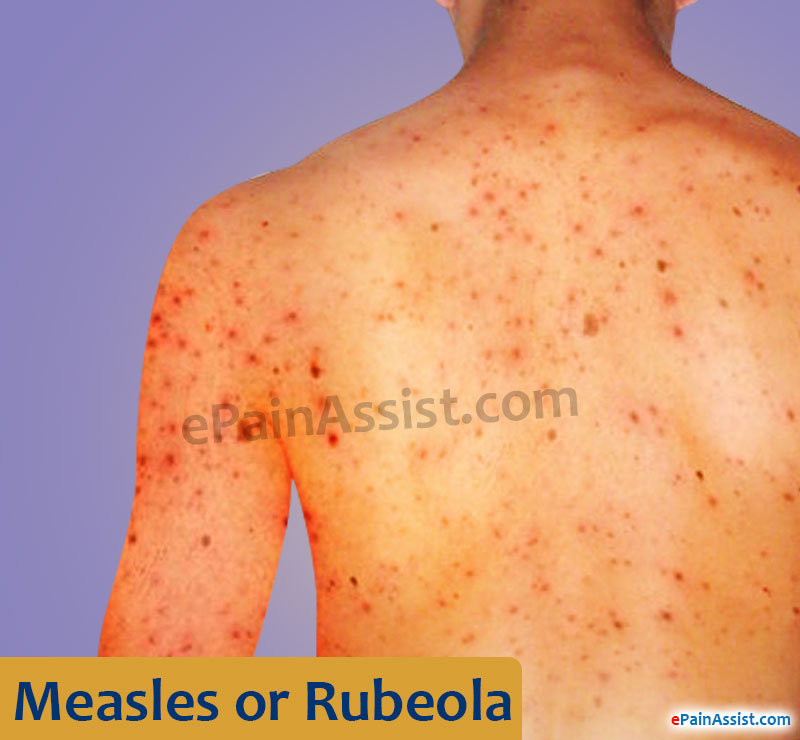Measles or Rubeola is a viral infection occurring in childhood. It used to be a common disease; however, it can now be prevented with a vaccine. Measles can be quite serious and dangerous for small babies. There is no treatment as such to get rid of an established infection, as the infection will run thought its stages and course and subside. However, medicines such as antipyretics, NSAIDs, can be given for fever relief. Other measures for alleviating discomfort, such as bed rest, lot of fluid intake and humidifier for cough and sore throat can be taken.
What Causes Measles or Rubeola?
Measles or Rubeola is caused by a virus, which is extremely contagious. This virus inhabits the nasal mucus and throat of a child or adult who is infected. The infected child/ adult are contagious for about four days before the appearance of the rash and for four days after it appears.
When a person with measles, sneezes or coughs, then the infection is transmitted via droplets into the air where it can be inhaled by others. The infected droplets can also land somewhere and remain active and contagious for many hours. This infection is also transmitted if a person after touching an infected surface touches their nose or mouth with the same fingers.
What Are The Risk Factors for Measles or Rubeola?
- Not taking vaccination.
- Having vitamin A deficiency.
- Traveling to countries where measles is prevalent.
What Are The Symptoms of Measles or Rubeola?
Symptoms Appear About 7 To 14 Days After Being Exposed To The Virus That Include:
- Fever.
- Runny nose.
- Dry cough.
- Sore throat.
- Conjunctivitis.
- Photophobia/sensitivity to light
- Appearance of Koplik’s spots, which are the small, white spots having bluish-white centers present on the cheek’s inner lining.
- Appearance of a skin rash, which is large and looks like flat blotches flowing into each other.
What Are The Stages of Measles or Rubeola?
- Infection and incubation is the initial stage where after the infection, the virus incubates for 7 to 14 days. Patient doesn’t have any symptoms in this stage.
- Nonspecific symptoms start to appear, such as slight fever, persistent cough, inflamed eyes, runny nose, and sore throat. This condition can last for 2 to 3 days.
- Appearance of rash consisting of small red spots, which can be slightly raised. Bumps and spots appear in small clusters giving the skin a splotchy red appearance. The rash first appears on the face, especially behind the ears and hairline. After a few days, the rash extends to the arms and trunk, after this to the thighs, legs and feet. In this stage the patient also has high fever.
- The rash from the measles slowly recedes and starts to fade from the face first and last from the thighs and feet.
- The last is the communicable stage where the patient can transmit the virus to people for around 8 days, about 4 days before the appearance of rash and till the rash is present for four days after.
How Measles or Rubeola is Investigated?
Physical exam is pretty conclusive due to the characteristic measles rash and Koplik’s spots. A blood test can be done to further confirm the diagnosis.
How is Measles or Rubeola Treated?
There is no proper treatment to get rid of an already established measles infection. Certain steps can be taken to protect those people who have already been exposed to the virus.
- Post-exposure vaccination can be given to adults and infants who have not been immunized. This vaccine is given within 72 hours of exposure to get protection from measles. If even after post-exposure vaccination, measles develop, then the symptoms won’t be as severe.
- Medications such as OTC antipyretics like acetaminophen and NSAIDs like ibuprofen and naproxen helps in bringing down the fever. Aspirin should not be given to children, as it carries the risk of Reye’s syndrome.
- Antibiotics can be given if the patient suffers from bacterial infection like ear infection or pneumonia.
- Vitamins A is given to those individuals who have deficient levels of vitamin A.
- Immune serum globulin is an injection of antibodies given to pregnant females, infants and those people who have a weakened immune system to prevent measles or to decrease the severity of measles within 6 days of exposure to the virus.
Lifestyle and Home Remedies for Measles or Rubeola
- Rest is important in any illness.
- Lot of fluid intake should be maintained.
- A humidifier helps in relieving sore throat and cough.
- Measles causes sensitivity to light, so it’s important to rest your child’ eyes and keep the lights dimmed or wear sunglasses. Reading and watching TV should also be avoided.
Also Read:

